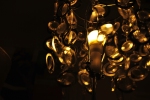dyeing was this time probably the most challenging part of the project as no one knew anything.. i like learning by talking to people and trying, but unfortunately no one knew anything properly, it was draining process that took months of reading few books and getting info online such as
Natural Dyes
Beautiful bright colors can be obtained by dyeing with natural dyes. Dyes can be gathered from nature or you can use dyestuff which will give you any color under the rainbow.
Alkanet Root: (Alkanna Tinctoria)
This will give colors from bluish grey to soft burgundy. This plant will grow like a weed if one wants to grow it.
Annato Seed: (Bixa Orellana)
Will give an orange shade, it is a good dye for cotton.
Brazilwood Dust: (Caesalpania Echinata)
This dye will give you reds. Before using the dust, expose it to the air and sprinkle with water and alcohol.
Cochineal: (Dactylopius Coccus)
The little cochineal bug will give the most color when ground into a fine powder. Obtainable colors are dark burgundy to bright red to soft lilac and pink.
Cutch Extract: (Acacia Catechu)
Cutch is a very easy dye. It will remain fast even on cottons and silks. It is good for combinations and produces brown tones if used by itself.
Indigo Natural: (Indigo Tinctotia)
Natural Indigo comes in blocks which, without further preparation, dyeing would not be possible as it does not dissolve in water. A recipe and reducing agent are needed. The color range that is produced is blue.
Indigo Solution Natural: (Saxony blue)
Produces a bright blue and is very easy to use, similar to a chemical dye. All of the dye will be absorbed in the fiber. It is not very good to dye cotton nor other vegetable fibers.
Loqwood Concentrate: (Hematoxylon Campechianum)
Expected colors anywhere from magenta’s and brown to purples and pink. A mordant is absolutely needed. The concentrated powder will give more bluish colors. It dyes cotton well.
Madderroot: (Rubia Tinctorum)
Is available in two forms: root or dust. Colors range anywhere from red to red-brown and oranges. It dyes cotton well.
Osage Orange Dust: (Maclura Pomifer)
Also available in two colors; bright yellow and gold. Two different colors can be obtained.
Red Sandalwood: (Pterocarpus)
This dye is beautiful for blending. It produces lovely browns, good shade combinations for doll hair.
Mordants for Natural Dyeing
Mordants are needed to set the color when using natural dyes. Different mordants will give different results.
Alum: (Aluminum Potassium Sulfate)
This is the most widely used mordant. Be careful not to use too much with wool, otherwise you will get a sticky feeling that doesn’t come out.
Copper: (Copper Sulfate)
This mordant is used to bring out the greens in dyes. It will also darken the dye colors, similar to using tin, but is less harsh.
*Chrome: (Potassium Dichromate)
Chrome brightens dye colors and is more commonly used with wool and mohair than with any other fiber.
Extremely toxic. Chrome should not be inhaled and gloves should be worn while working with chrome. Left over mordant water should be disposed of at a chemical waste disposal site and treated as hazardous waste.
Iron: (Ferrous Sulfate)
Dulls and darkens dye colours. Using too much will make the fiber brittle.
Glaubersalt: (Sodium Sulfate)
Used in natural dyes to level out the bath. Also use in chemical dye.
Spectralite: (Thiourea Dioxide)
This is a reducing agent for indigo dyeing.
Tara Powder: (Caesalpinia Spinosa)
Tara Powder is a natural tannin product. It is needed for darker colors on cotton, linen and hemp.
Tartaric Acid: A must for cochineal. This mordant will expand the cochineal colors.
Tin: (Stannous Chloride)
Tin will give extra bright colors to reds, oranges and yellows on protein fibers. Using too much will make wool and silk brittle. To avoid this you can add a pinch of tin at the end of the dying time with fiber that was premordanted with alum. Tin is not commonly used with cellulose fibers.
Calcium Carbonate:
Is to be used with indigo powder for the saxon blue color. It can also be used to lower the acidity of a dyebath.
but after natural dyes are not the most reliable of all as every time it cathces in different shade and likes getting spotty etc. also finding aout what is alum and why i should use washing soda and what it is.. handweavers studio in N7 was a good source for getting natural (not vegetable dyes) but didnt know anything about the procedure.. told me to follow the instruction on a leaflet they gave me, which completely contradicted with instructions in the book – tried both, neither of them actually worked , so i did something in between.. also some fabrics and fibres needed to be mordanted some not.. some kinds of silk yes and some no. its been such and adventure of damaged hands, colouring everything from turmeric and intense smell of cabbage as well as cutting the fabrics into pieces and after first load finding out that the fabric (its bamboo silk i am talk about) is not working out with dyes well..
ive learned that animal fibres are much better for dyeing than vegetable based ones and that if you mix all! colours together, you most certainly can get black.. even everyone says it is impossible from natural and vegetable dyes…





























































































































































































































































































































































































































